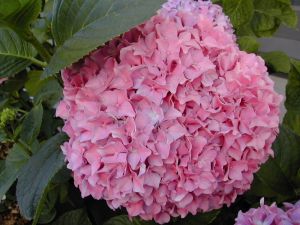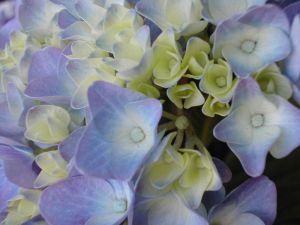15 July 2015
Understanding Hydrangeas
 The flower colour of hydrangeas that aren’t white are in the blue and pink colour ranges. These shades change in response to the acidity or the alkalinity of the soil they are grown in. If you have chalky soil your blue-flowered hydrangea will gradually change to pink. This can be upsetting if you’ve planned a dreamy blue-flowered garden. If you can successfully grow healthy camellias or any rhododendrons in your garden borders, you have acidic soil. If you can grow blueberries, you have very acidic soil. Otherwise, it is likely that your soil is neutral or alkaline. You can grow your hydrangea in a container with acidic compost, and water using rainwater. It is worth the effort for one fabulous blue specimen. Blue flower treatments The acid to alkaline measure or the soil’s pH is, like earthquake measurements, increased by ten with each unit. Neutral soil is pH 7, and acidic soil at pH 6 is ten times more acidic than neutral. Although it is possible to ‘blue-up’ your hydrangeas, it only really works if your soil is slightly, rather than extremely acidic. In the old days, piles of nails were put round hydrangeas to release iron into the soil.
The flower colour of hydrangeas that aren’t white are in the blue and pink colour ranges. These shades change in response to the acidity or the alkalinity of the soil they are grown in. If you have chalky soil your blue-flowered hydrangea will gradually change to pink. This can be upsetting if you’ve planned a dreamy blue-flowered garden. If you can successfully grow healthy camellias or any rhododendrons in your garden borders, you have acidic soil. If you can grow blueberries, you have very acidic soil. Otherwise, it is likely that your soil is neutral or alkaline. You can grow your hydrangea in a container with acidic compost, and water using rainwater. It is worth the effort for one fabulous blue specimen. Blue flower treatments The acid to alkaline measure or the soil’s pH is, like earthquake measurements, increased by ten with each unit. Neutral soil is pH 7, and acidic soil at pH 6 is ten times more acidic than neutral. Although it is possible to ‘blue-up’ your hydrangeas, it only really works if your soil is slightly, rather than extremely acidic. In the old days, piles of nails were put round hydrangeas to release iron into the soil.  The mineral aluminium is largely responsible for Hydrangea ‘blues’. Alkalinity “locks up” the aluminium so the plant can’t absorb it, the addition of iron to the soil releases the aluminium content to the plant. Nowadays ’treatment’ comes in packets. Sequestrol which contains Iron chelate, can be watered in to the soil. Aluminium sulphate applied at 250 grams to the square metre, puts aluminium into the soil which the plant can absorb. Sulphur applied at 150 grams per square metre, lowers the pH by a useful 0.5. Treatments are likely to be needed annually, and using rainwater rather than the generally alkaline tap water helps when watering. An old party trick is to blue-up just one side of a hydrangea, so you get different flower colours on the same plant! Mopheads and Lacecaps Hydrangea flowers, especially in the case of the common garden ‘macrophylla’ form, have two types of flower. The “mophead” (Hortensia) has big, rounded flowerheads packed with individual florets that are sterile, and tiny fertile flowers that are hardly visible. The “lacecap” heads are flattish, and have tiny fertile flowers at their heart and showy infertile ones, often held on short stems, round the edges. Hydrangea macrophylla Early Blue = 'Hba 202911' is a mophead, while Hydrangea macrophylla 'Taube' (Teller Series) is a lacecap. From traditional to trendy The rather stolid image of the hydrangea has changed in recent years. Some of the new varieties are elegant, even dramatic. Hydrangeas have an important role to play in the most modern and stylish garden. One change to modern forms doesn’t involve the flowers at all. Varieties are now available that have shiny black stems, such as Hydrangea macrophylla 'Black Steel Zebra'. Other varieties have near black foliage and flowers that change colour with age. These, and many more will be covered in next month’s article “Using hydrangeas in the garden”. Enjoy! This blog post was contributed by Susan A. Tindall
The mineral aluminium is largely responsible for Hydrangea ‘blues’. Alkalinity “locks up” the aluminium so the plant can’t absorb it, the addition of iron to the soil releases the aluminium content to the plant. Nowadays ’treatment’ comes in packets. Sequestrol which contains Iron chelate, can be watered in to the soil. Aluminium sulphate applied at 250 grams to the square metre, puts aluminium into the soil which the plant can absorb. Sulphur applied at 150 grams per square metre, lowers the pH by a useful 0.5. Treatments are likely to be needed annually, and using rainwater rather than the generally alkaline tap water helps when watering. An old party trick is to blue-up just one side of a hydrangea, so you get different flower colours on the same plant! Mopheads and Lacecaps Hydrangea flowers, especially in the case of the common garden ‘macrophylla’ form, have two types of flower. The “mophead” (Hortensia) has big, rounded flowerheads packed with individual florets that are sterile, and tiny fertile flowers that are hardly visible. The “lacecap” heads are flattish, and have tiny fertile flowers at their heart and showy infertile ones, often held on short stems, round the edges. Hydrangea macrophylla Early Blue = 'Hba 202911' is a mophead, while Hydrangea macrophylla 'Taube' (Teller Series) is a lacecap. From traditional to trendy The rather stolid image of the hydrangea has changed in recent years. Some of the new varieties are elegant, even dramatic. Hydrangeas have an important role to play in the most modern and stylish garden. One change to modern forms doesn’t involve the flowers at all. Varieties are now available that have shiny black stems, such as Hydrangea macrophylla 'Black Steel Zebra'. Other varieties have near black foliage and flowers that change colour with age. These, and many more will be covered in next month’s article “Using hydrangeas in the garden”. Enjoy! This blog post was contributed by Susan A. Tindall






